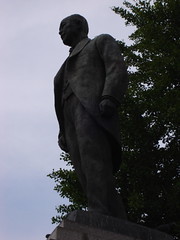 If you go to the Marunouchi side of Tokyo Station, you can see a big statue of this fellow, Masaru Inoue (井上勝).
If you go to the Marunouchi side of Tokyo Station, you can see a big statue of this fellow, Masaru Inoue (井上勝).
Inoue was one of five Choshu samurai sentsmuggled to England in the mid-1860s to figure out how to modernize Japan. He studied railway technology at the University College London, and following his return to Japan served as head of the Japanese national railway program, in some form or another, from 1869 to 1893. During this time he supervised the building of Japan’s first railway line from Tokyo to Yokohama (the first Tokyo station has been reconstructed and can now be seen in Shiodome), and the eventual completion of the Tokaido Main Line between Tokyo and Kobe in 1889.
In his later years he was made a Viscount and served in the House of Peers (sort of the old Japanese equivalent of Britain’s House of Lords). He is also the last “i” in the Koiwai food company, which he co-founded in 1891.
So next time you pass through Tokyo Station, tip your hat to a fellow who helped pave the way for the most awesome railway system in the world. (Or, if you don’t have a hat, do what I do and just take pictures.)

And …. so I heard …. his study in the UK is the reason why Japanese trains travel on the left hand side of parallel tracks. When automobiles arrived they mirrored the trains like the UK and that’s why Japan drives on the left too.
The Straight Dope says “The English minister to Japan achieved the coup of his career in 1859 when he persuaded his hosts to make keep-left the law in the future home of Toyota and Mitsubishi” but gives no more details and it is too late to look anything more up. However Japanese sites talk about samurai walking on the left for the same reason as most people carrying swords did. A good third of the world drives left, and the mystery is rather why people drive right. Rather, why Napoleon forced so much of Europe to do so, and why the US even joined in. Enlightenment ideals of a break from the past?
Sent = smuggled
I’ve actually heard the sword story in relation to Napoleon… It goes something like “To reduce the risk of his troops falling victim to sneak attacks by groups of random strangers wielding concealed swords or other weapons when they were out on the march, Napoleon made peasants walk on the right. Previously they had walked on the left, which is why Britain, which never fell to Napoleon, is different from the rest of Europe.” I don’t know how true this is, but it is interesting to note that some parts of Europe that never fell to Napoleon – like Sweden – drove on the left until fairly recently.
Wikipedia’s page on this subject is actually really informative:
http://en.wikipedia.org/wiki/Driving_on_the_left_or_right
Re Japan it says: An informal practice of left-hand passage dates at least to the Edo period, when samurai are said to have passed each other to the left in order to avoid knocking swords with each other (as swords were always worn to the left side). During the late 1800s, Japan built its first railways with British technical assistance, and double-tracked railways adopted the British practice of running on the left. However, army troops were ordered to keep to the right while travelling on roads, creating a double standard that was not legally resolved until 1924, when all road travel in Japan switched to the left.
And thanks, Mulboyne. I could never be a historian because I always get some detail wrong…
What is strange is that Okinawa took so long to revert to the left.
“Japanese armies were keeping right on roads, as their ideas did, until 1924.”
Cute. (That’s from http://www.2pass.co.uk/japan.htm, the souce Wikipedia uses.)
It also notes that the road became that way due to trams being trains (thus on the left) and then trams (being on roads) affecting car traffic.
Too many history books waste pages on boring stuff like the formation of the Seiyukai and importance of the Hara Cabinet and not enough on really important stuff like this….
In the early days of course there simply wasn’t enough car traffic to require rigid rules. Most of the automoble ads I have seen in prewar newspapers etc are for American cars like Packard and Ford. Looking at a few photos from the late 19th C, as far as any general trend can be determined, and there really isn’t enough traffic to make it clear at all, there is a vague tendency to favour right-hand passage over left.
Incidentally, has anyone see the “Choshu Five” movie made about him, Inoue Kaoru, Ito Hirobumi, and the others who went on this secret mission? Any good?
I only remember that detail because it was Thomas Glover who arranged for them to hide on a ship owned by Jardine Matheson bound for Hong Kong. Among his larger activities as an arms dealer, Glover took over the Spring Valley Brewery in Yokohama with money from the Iwasaki family. It became Kirin Brewery and, since the Iwasakis founded the Mitsubishi empire, it remains part of that group today. Kanpai!